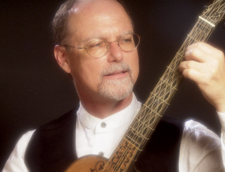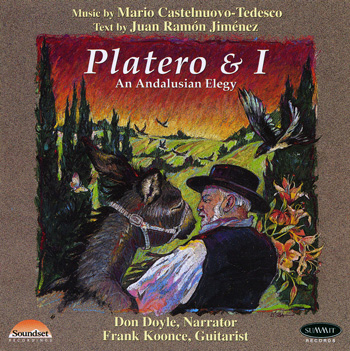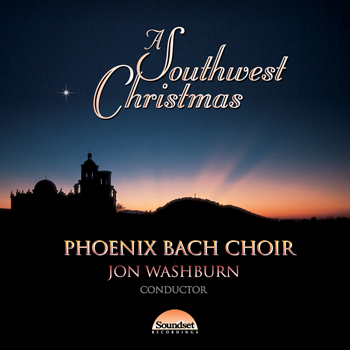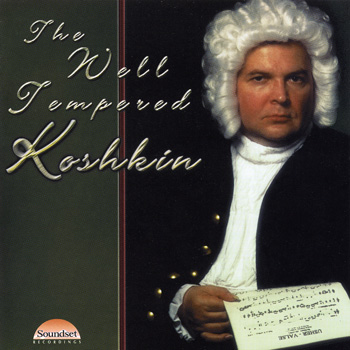Nobel Prize-winning Andalusian poet Juan Ramón Jiménez is most remembered for "Platero y yo," his 1917 collection of tender reflections on his beloved little donkey. In 1960 Mario Castelnuovo-Tedesco wrote guitar accompaniments to be played with the recitation of 28 of the 32 short chapters. His music perfectly suits the character of the texts -- gentle, idyllic, pastoral, sometimes playful, and sometimes melancholy. Castelnuovo-Tedesco was astute in calculating the relationship between the words and the music, and they complement each other beautifully, without overwhelming each other, but the music is of enough interest that it could exist independently of the text. The alchemy of words and music in this recording of 17 of the movements with speaker Nelson Brenes and guitarist Frank Koonce creates a wonderfully complete experience. Both perform with a reserve and understatement that suit the text ideally, never falling into broad humor or pathos that could weaken the work's gentle impact. Brenes, an operatic baritone, delivers the text with directness and sensitivity, and he's well matched with Koonce's relaxed and expressive playing. The sound is clean and intimate. The CD is beautifully produced, with charming pen and ink illustrations from an early edition of the text. It should be of interest to fans of Spanish-flavored guitar music, and of spoken poetry with musical accompaniment.
-by Stephen Eddins, allmusicguide.com
An established and respected exponent of Castelnuovo-Tedesco's musical depictions of Jiménez' celebrated word paintings, Frank Koonce last released this selection of 17 movements on disc in 1995. He was then working alongside the actor Don Doyle, who offered a suitably wholesome account of the text in its English translation. More than a decade down the line, Koonce revisits the terrain with the poet's words presented in the original Spanish. Given that the movements chosen are the same and the running order, apart from the reversal of Juegos del Anochecer and Idilio de Noviembre, is unchanged, we're essentially addressing a question of the lingo.
Like the majority of monoglot English listeners, my capacity to understand even the most precisely enunciated Spanish is nowhere near good enough to keep up with proceedings here. This means the rich and expressive voice of Brenes, who bursts into song on several occasions, effectively takes on the role of an additional instrument. Once you've gotten used to it, this is no bad thing, for the English translations had two regrettable by-products. First, and most obviously, they inevitably diverted attention from the music, which, as Segovia spotted at the outset, has more than enough depth and diversity to go it alone in a recital programme. The second problem is that the words of Jiménez lose much of their flow in translation. To take just one example from the very first line, 'Platero es pequeño, peludo, suave' may well be informing us in literal terms that our four-legged hero is 'little, shaggy and soft', but I seriously doubt if Jiménez would have put it quite that way if he'd been writing in English as his native tongue. So is there a case to be made for leaving the story of Platero undisturbed in the words his creator understood?
Having just spent a pleasant afternoon in the company of this lavishly presented release, I'm inclined to think so. The booklet includes full translations, although these are perhaps best read separately from the performance. The voice of Brenes and the guitar of Koonce are more than enough in themselves to fire up the imagination.
-by Paul Fowles, Classical Guitar Magazine (UK)
Many years ago, I attended a concert at the North Carolina School of the Arts where the Castelnuovo-Tedesco Platero y yo was performed in its intended form. The blending of the Italian composer's music with the evocative text by Nobel Prize-winning Juan Ramón Jiménez was a wonderful experience. While the guitar works stand on their own very well for the most part, the words are so beautiful that hearing them together is magical. Koonce and Brenes have selected seventeen of the pieces for this disc and each one is a gem. It is hard to imagine how either narrator or guitarist could be bettered. Koonce plays with complete mastery and wonderful expressiveness. Brenes has a glorious speaking voice (and sings nicely at times too) and delivers the text with great drama wile still managing to avoid any "stage-y" histrionics. The recorded sound is beautiful. It may take a minute or two to enter the acoustic world the artist/producers have created, but quickly one enjoys the overall sound and the balance of voice and guitar. It is obvious that being a Spanish-speaker will enhance one's appreciation of this work, but the narration can be appreciated for its sonorities alone. Luckily, comprehension can be guaranteed by a beautifully produced booklet included with the disc. It has Spanish and English texts, and charming illustrations from a 1922 edition of the book. In case it should make a difference to anyone, Brenes delivers the text in very elegant Latin-American Spanish. I like it, but if you are expecting an earful of zetas you will be disappointed!
-by Al Kunze, Soundboard
Nobel laureate Juan Ramón Jiménez's Platero y yo ("Platero and I") celebrates his friendship with a little donkey, as well as life in his natal village of Muguer. I've never read it, but I've known the title for many years. The booklet is a little confusing about the story's form, referring to it as a prose work, yet the quotations accompanying the charming illustrations are obviously intended as poetry. Whatever the form, the book's colorful, sweet, melancholy, and even tragic reflections have earned it enduring popularity. It's often thought of as a children's book, but the author refuted that idea in his prologue to a 1913 abridged edition. Castelnuovo-Tedesco, the composer of over 300 film scores (among them Gaslight and And Then There Were None), responded to the story's dramatic potential by setting 28 of the verses for guitar (Frank Koonce has selected 17 for this disc). Andres Segovia recorded 10, but without the narration which is an important element of the set and of this recording.
Although Nelson Brenes reads the verses beautifully-his inflection, pacing, and occasional singing are moving even in what is for me, a foreign language-I would have liked the producers to have included a second, music only CD. It's possible that I might react differently to an English version, which would make it easier for me to appreciate the interrelation of sound and story. Prospective listeners will have to decide this issue for themselves. In any case, Castelnuovo-Tedesco's music is polished to his usual high standard, unmistakably Spanish, and perfectly suited to the guitar and the story's range of emotions. Soloist Koonce plays superbly with excellent musical instincts, infallibly finding just the right tempo and tone to characterize each moment of the score deftly. (Check to see if there are any other full versions available, verses and all.) The producers have done all they could to make this an elegant release, enclosing the notes, verses, and illustrations in a small book bound into the jewel box. If you don't mind having to hear the narration every time you listen to the music, then there's no reason not to acquire this for yourself.
-by Robert Schulslaper, Fanfare, Sept/Oct 2009
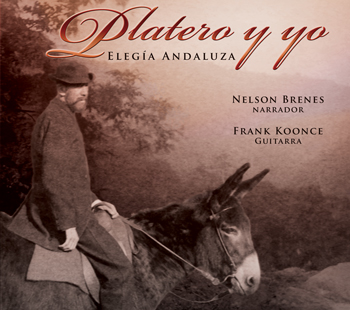

 Amazon
Amazon